There’s a bank of computers lined up in a lobby, and a group of people are gathered around every one. In the midst of each group is someone explaining what they’re seeing on screen. On one screen, someone is directing children and pineapples around a school to teach them about magic. On another, someone is running through a side scroller set to the beat of a song streaming through his large headphones. On yet another, players have strange headsets strapped to their head that detect their focus and calmness to affect their in-game powers.
Everyone playing and watching has a smile on their face and they’re excited to see what they might be playing in their own homes soon. The proud developers stand next to their projects, positively glowing, overjoyed to share their babies with the world. It was hard to not be excited about all of the projects, with the way everyone talked about the tech they built or the unique stories they wanted to share.
Was this what GDC was supposed to be?
—–
It’s important to point out that this is the first time The Mary Sue has had someone cover the event in person. There were a fair number of people who asked why The Mary Sue was here. I had to think for a second, because with the most self-evident reason aside (video games are for everyone, come on), I wasn’t exactly sure. I knew GDC was important as the premiere professional conference of choice for video game developers throughout the world. But I wasn’t sure how that fit in with what The Mary Sue stands for.
Then it hit me.
I’m not here to report about new tech, or how one company is gamifying paying bills. I set out to find out if the conversations we’ve been having about changing the way we see, interact with, and play games are the same conversations they’re having within the industry. More than that, I wanted to see if the industry and those who worked in it were actually paying attention to any of the stories coming from some of gaming’s most marginalized groups: women, minorities, people of color, and all combinations thereof and beyond.
I wanted to find out if we were getting through to anybody.
—–
The room I’m in is empty except for six or seven of us gathered around a table covered in an immaculate white tablecloth. To my left sits a fellow attendee wearing a Gaming’s Feminist Illuminati t-shirt. To my right sits none other than Brianna Wu, co-founder of Giant Spacekat Games. Everyone picks up a chair from somewhere around the room, and we all drag them over to the empty table and smile nervously at each other. We’re in the panel wrap-up room, where discussions can be had after the official panel has ended.
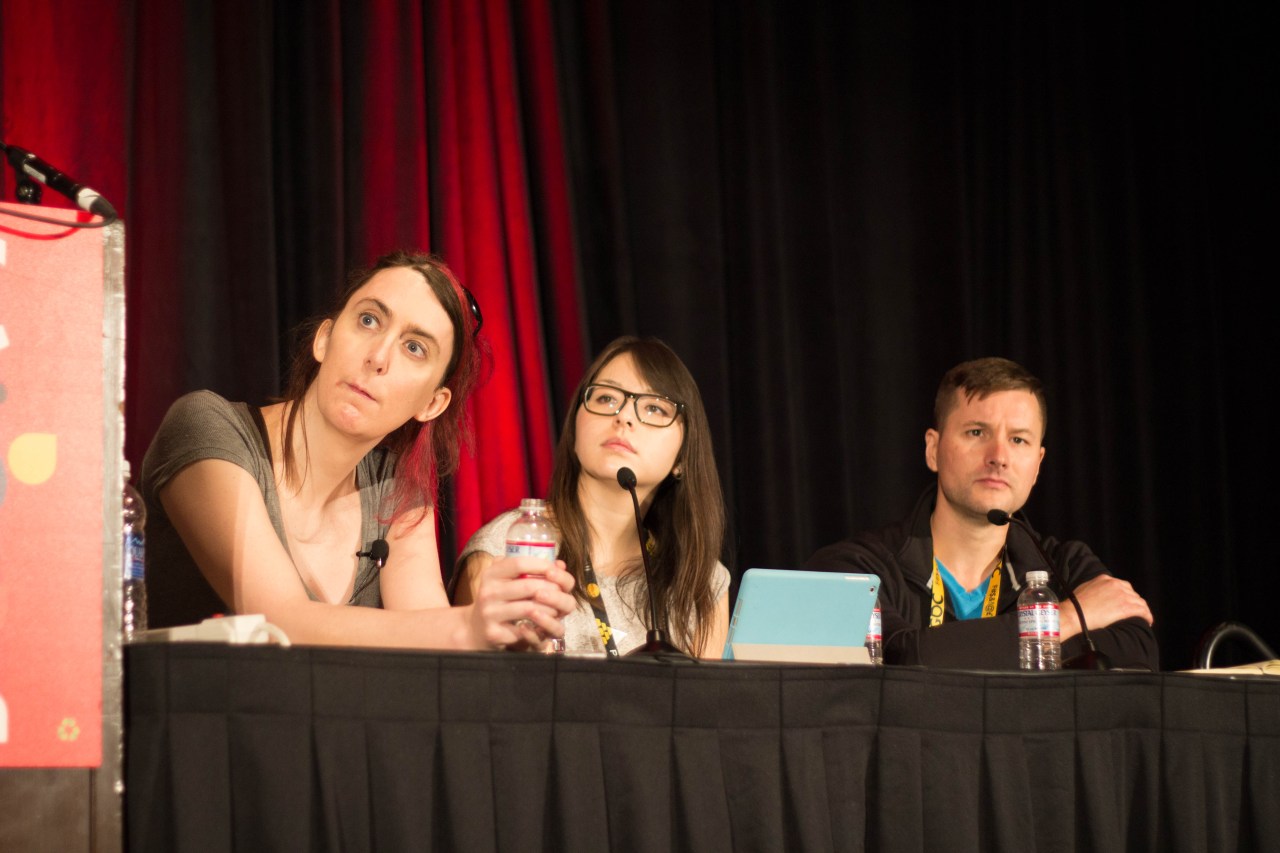
Brianna Wu, Mariel Cartwright, and Jonathan Cooper at an animation bootcamp on how women are not too hard to animate.
Introductions give way to a discussion about trying to find ourselves in the games we play. One girl begins to talk about how when she was younger, the only character she saw like herself in a video game was Ursula, from the Little Mermaid video game. Her voice cracks as she speaks. “That was it. I’m supposed to be the villain, here? Evil? Because I’m bigger?” She stops to wipe her face, and the girl next to her pats her on the shoulder in comfort. Everyone at the table is quiet, but we all sympathize.
In this industry, it’s incredibly easy to feel like you’re not wanted.
Later, after the post-panel meetup, I spoke with Brianna Wu about what life’s been like for her lately, and what she’s been doing to get past the eternal August of GamerGate. “I feel my role is to serve as an industry insider, to be a bit more developer focused,” she said. “I feel like I’ve been a vocal advocate for the community, though I’ve gotten things wrong.”
A while back, Wu caught heat from a lot of people in the trans community regarding how she’s handled talking about trans issues. She says, “I’ve adjusted the ways I talk about it, and I’m really hearing people.” The earnestness is evident on her face as she continued. “It’s important to hear the critiques, and I make it a point to connect.”
In the midst of GamerGate’s rise to infamy, Wu was caught up as one of the main targets of its movement to push women out of gaming. “You know, I was sleep deprived, I looked incredibly stressed on TV and everything.” She looked down at her notebook and fiddles with one of her Revolution 60 character sketches. “I pulled within myself, because I wanted to change the narrative. It felt like we were losing.” She looked up at me. “I believe I helped turn the tide of that war.”
—–
The next day, I entered GDC more than a little sore from running around so much. The conference encompasses three separate buildings, all in the heart of downtown San Francisco. The number of conference attendees often overwhelms the city as the sidewalks are completely crushed with a yellow badge-wearing flood of people. It’s quite fun seeing so many people gathered in San Francisco to talk about and discuss video games, a real departure from the usual tech conferences that happen in the city all year.
A lot of the panels and talks were spread out over the three convention halls, so you’d find yourself running from one to the other to make it over to the room on time. Along the way, you could find a bunch of impromptu conversations cropping up. People would be talking about anything: new game engines, what project they happened to be working on, or even new methods of storytelling. If being surrounded by computers and people playing video games didn’t tip you off that you were at GDC, it’d be overhearing people talk about video games so casually.
I took the opportunity to ask a few attendees—game developers, artists, writers, and enthusiasts alike—about what their GDC experience was like. They ran the gamut. Many people were there for their first time, but the vast majority were people who’ve been in the industry for a while, and have been to GDC multiple times before.
As I watched someone playing No Pineapple Left Behind, a game about trying to run a school filled with sentient pineapples and children, I got into a few conversations with developers and attendees. I asked them whether anything was different between the last conference in 2014 and this one in 2015.
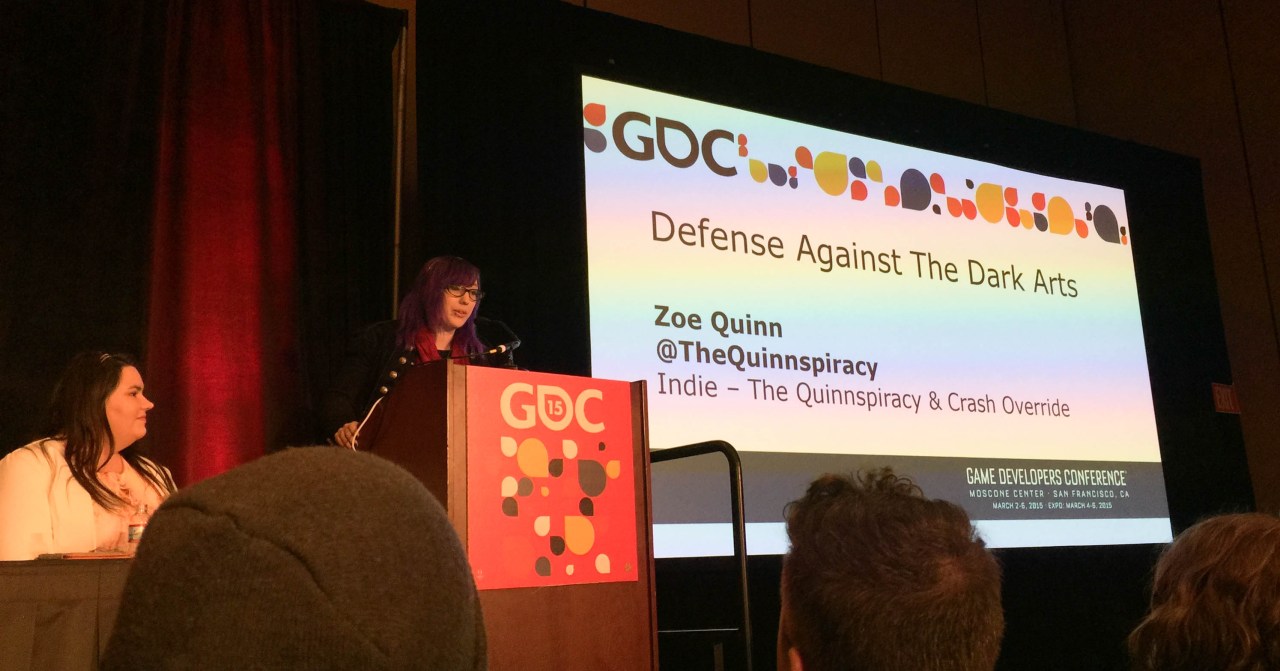
Zoe Quinn, sharing protips on how to best defend against the Voldemort that is GamerGate.
For a lot of them, they said that this year’s conference felt more focused on indie games and developers. With a whole section of a giant lobby dedicated to showcasing indie games, they weren’t kidding. Even judging by the speaker list, you’ll find that a lot of the people leading panels and sessions are indie developers and writers: Nina Freeman, Brianna Wu, Zoe Quinn, Jenova Chen, and countless others.
One of the major developments of this GDC was the release of Unreal Engine 4 as a free tool, open to developers everywhere. The rising prevalence of free yet powerful middleware game engines like Unreal, Unity, and Source may be heralding a future in which indie developers will have the same tools as AAA companies.
—–
John O’Neill is probably one of the most friendliest CEOs of any company I’ve ever met. He runs Spark Plug Games, the developer behind Firefly Online. I met him outside, next to a tea lounge on the roof of one of the halls. There’s a bunch of other media people nearby, sitting on benches and talking with developers and publishers, all reporting on the day’s events. He explained to me how a future focused on content, not tech, would look like.
“When you’re developing a game, you have to decide if you’re building tech or game content,” he said. Having pre-made engines to play in “evens the playing field.” Since a lot of the tech is already made for you in open source engines like Unity (which Firefly Online is based on), he says you can choose to go with “smaller teams, and better experiences.”
From the moment I sat down to the moment I got up to leave, it was clear to me how much O’Neill valued the community. It was evident how much he treasured being able to listen to their concerns, and interact with them on a daily basis.
I asked O’Neill how being a small team worked with developing a game for such a storied franchise like Firefly. “This game is for them, the fans get it first,” he said. Every time he brought up the fans, he smiled even brighter. “There’s such a diverse fanbase of people who don’t game a whole lot, so it means a lot when they say they’re willing to learn how to play this game.”
His excitement over creating something so new in a world with such a strong fandom was incredibly infectious. “We interact with the fans every day, and we really want to make sure we listen to them as much as we can.”
—–
By the time Wednesday rolled around, it was clear that a lot of people were running a little ragged. Bags started to show up under peoples’ eyes, folks weren’t hustling so quickly to get to sessions, and the halls somehow seemed a lot quieter. For a lot of attendees, they had been going to parties two nights straight at that point, and while their energy levels seemed low, their excitement didn’t change.
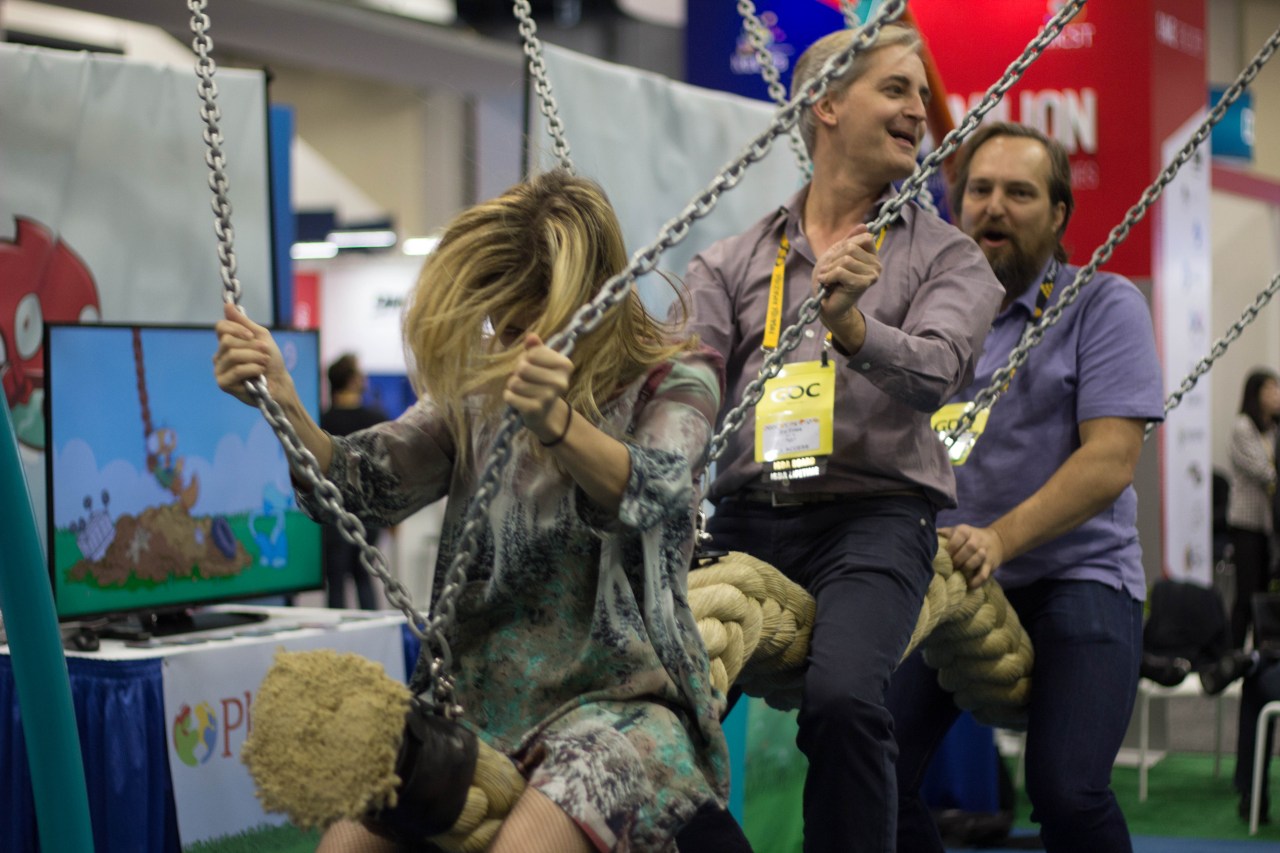
GDC attendees playing a game where you ride a rope swing. No lines for this one, if you can believe it.
On Wednesday, the Expo Hall opened. This is where a lot of the big, AAA developers showed off their wares in giant booths that were larger than my apartment. PlayStation and Microsoft were in attendance, and showing off their newest games and systems to anyone interested. Many other gaming startups dedicated to helping mobile game developers make money were there, as well.
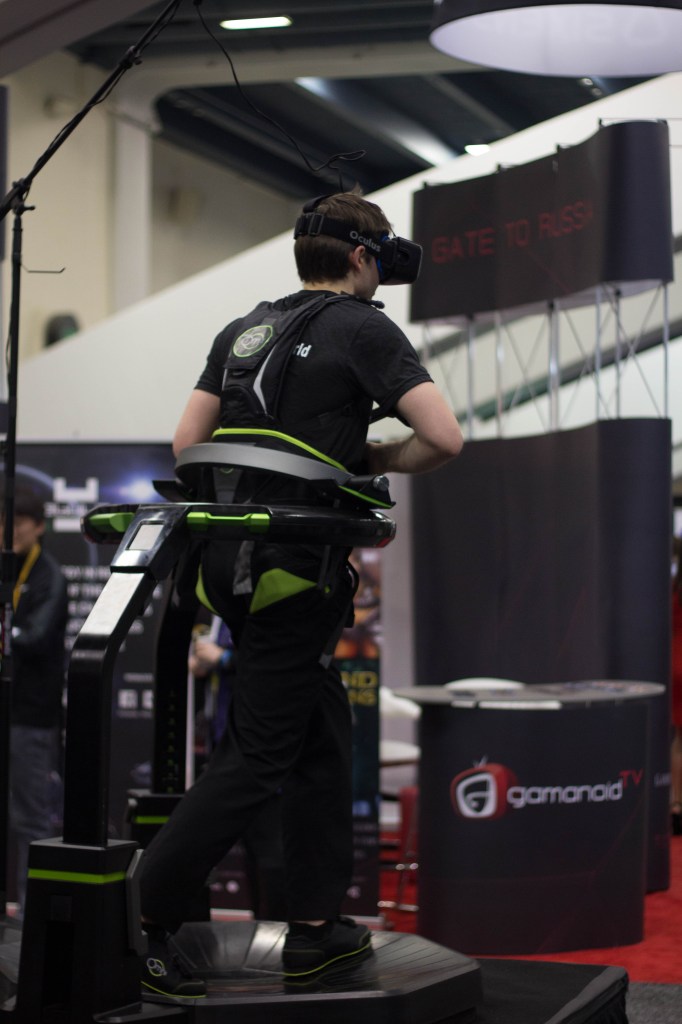
Full body motion and orientation setup for VR headsets.
Tucked into a corner of the Expo Hall was the Independent Games Festival (IGF) exhibition. Here, many indie developers whose projects were nominated for an IGF Award shared their games with GDC attendees.
Easily one of the busiest sections of the Expo Hall, it saw plenty of attendees passing through all week. Many of the developers sat next to their nominated games and answered questions from people who wanted to find out the whys and wherefores about their games. The availability of developers and their willingness to sit with their finished projects is something that struck me as I wandered around the IGF exhibition as well as the other part of the hall that was dedicated to independent studios.
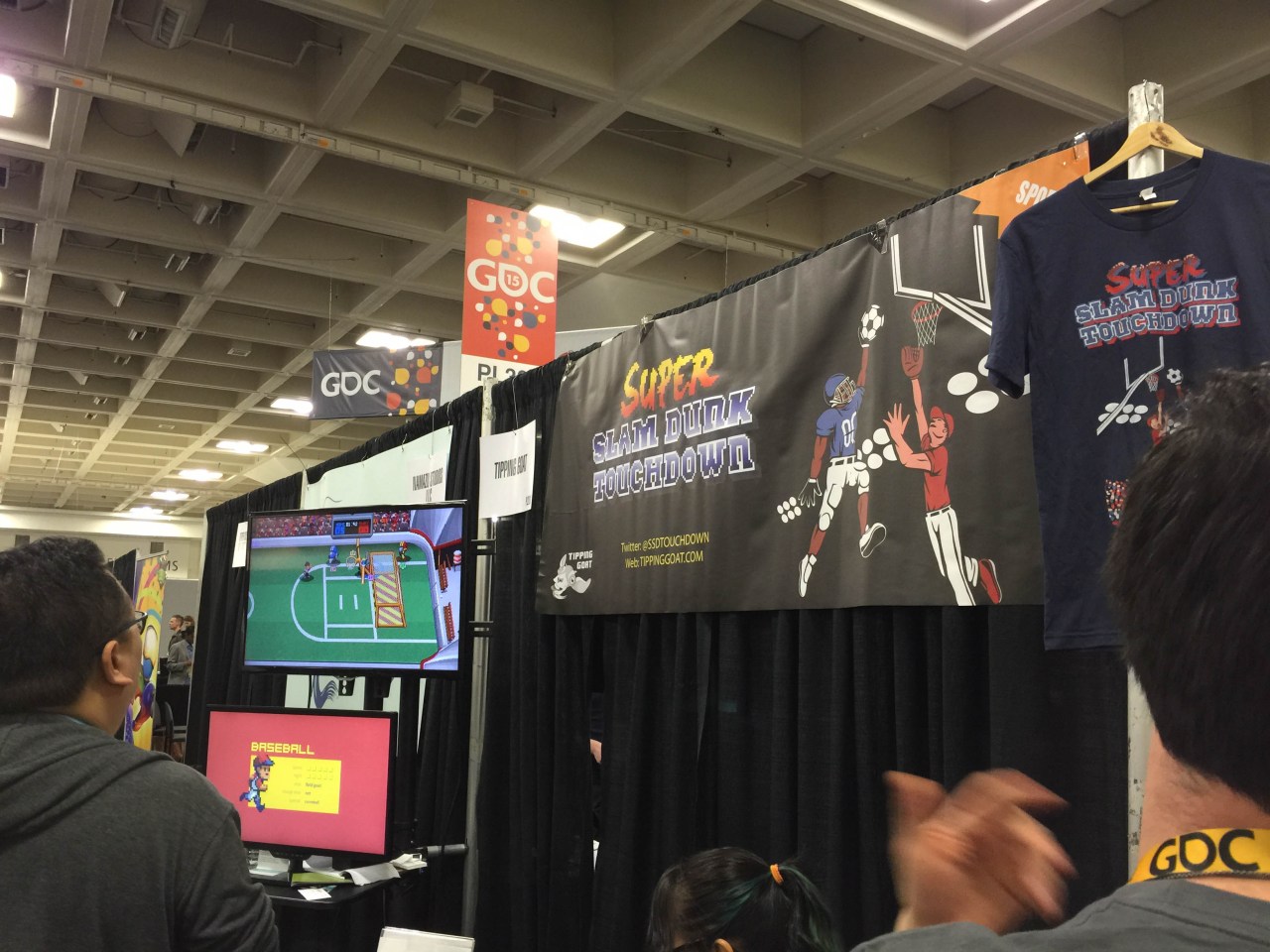
The booth for “Super Slam Dunk Touchdown,” a hilarious sports mashup game.
In one of the other halls that featured indie studios, I was immediately pulled into a demo at a booth showing off an 8-bit sports game called Super Slam Dunk Touchdown. It combined literally every sport together in an absurdly funny mashup. As I guided my roller derby girl avatar down a hockey rink to steal the bowling ball from the hockey player trying to score, I couldn’t help but laugh.
There were a small handful of players in this round, and we were all having a blast playing this wacky game as the developer, Rick Felice, beamed behind us and cheered us on. It was just pure fun.
—–
The thing you have to realize about GDC is that there’s essentially two sides to the GDC coin. There’s the conference that happens during the day: people talk about new projects, new tech, or anything else that’s going on with their work. Then, there’s the parties and the socializing and networking that happens at night.
That’s how I found myself sipping whiskey on a crowded dance floor playing a video game about trying to put together Ikea furniture without instructions while talking with the game’s developer as Kanye West was playing over the loudspeaker, telling me to throw my hands up in the sky. Billed as one of the best parties of GDC, Wild Rumpus features some of gaming’s most imaginative and unique games are shown off in a club setting where DJs spin music for the massive crowd.
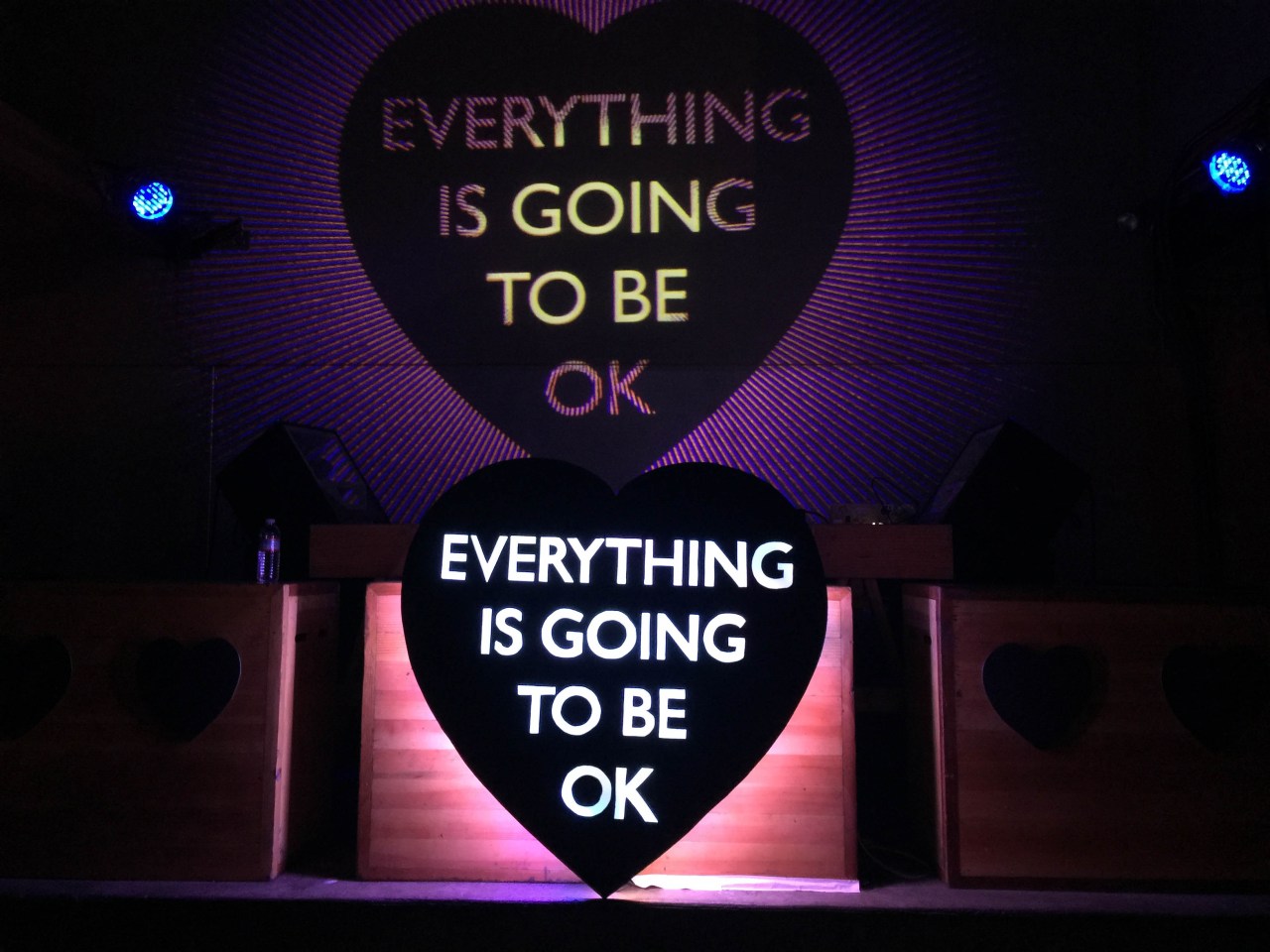
The stage at the Wild Rumpus party.
The best part about Wild Rumpus is that it’s open to attendees and non-attendees alike. It was great seeing people there who may not have been able to afford an expensive GDC pass still sharing their games and stories with a great group of people. Being able to see developers and writers in both professional and casual lights can be a good reminder sometimes that at the end of the day, no matter where we are, we’re all bonded by a love of the game.
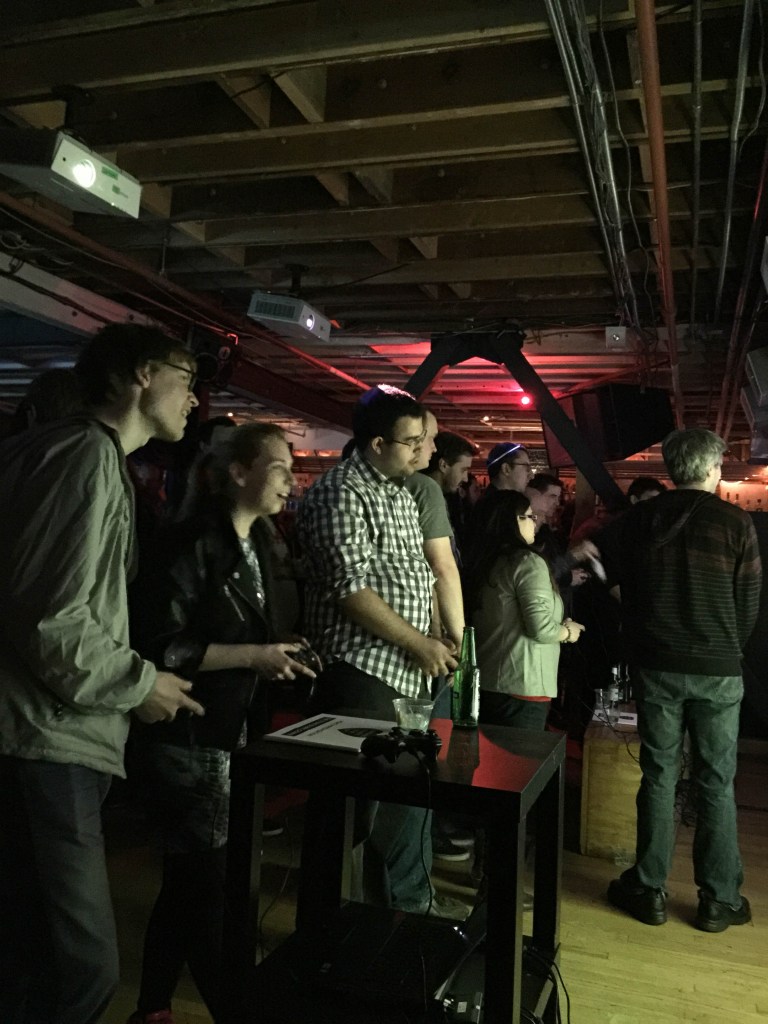
A bunch of Wild Rumpus attendees playing “Home Improvisation,” a game about building Ikea furniture without instructions.
—–
The last two days of GDC were mostly a blur. However, something that will stick out in my mind for quite some time was the #1ReasonToBe panel on Thursday. I wrote about the panel in detail earlier last week, but I’ll say here that how I felt walking out into the hall after that panel was not how I felt walking in.
I thought I had a strong idea of what GDC is supposed to be. I thought I had everything dialed in. I figured GDC was a professional event, where everyone who made games could have conversations among their peers to essentially decide the future of our mutual passion: games. I went into the conference imagining the tone of the conversations to be high-minded and incredibly professional. I worried it would be stuffy.
But the #1ReasonToBe panel, perhaps the most attended panel of the entire conference next to the Experimental Games Workshop, changed the way I thought about GDC. As women in the industry shared their own experiences and why they fight to remain in gaming, I found myself re-thinking why I was there.
As a whole, GDC serves as a focal point for all of gaming’s most influential people. To them, GDC feels a lot like a reunion, a place where they can see old friends, meet new ones, and learn from everyone involved. But more than that, they all come together to talk about what’s been going on in the world of games as of late. It’s a place for them to be among equals, among peers who understand and relate to the struggles that plague the industry day in and day out.
With everyone I spoke to, the feeling was the same: this year’s GDC felt like a turning point. People spoke of how exciting it was to see independent games—often a vessel for the marginalized groups within gaming to share their stories—on the rise. Others shared excitement at how much the face of gaming has changed to represent more than just the stereotypical cis, straight, white male audience.
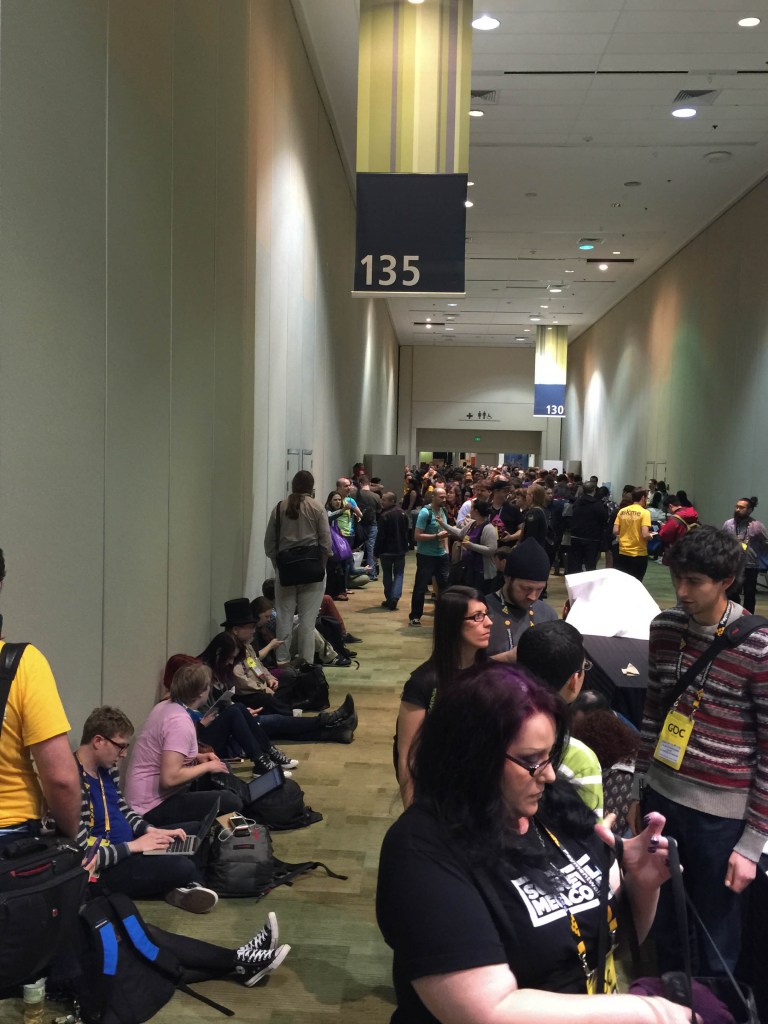
The line outside the #1ReasonToBe panel. The room was absolutely PACKED.
In their own way, the people behind GDC have been able to subtly change the way the industry views these important works. By highlighting and featuring these stories, they begin to cement them as part of gaming’s cultural landscape.
That was it. If GDC is supposed to represent what’s new and big and important in games, then these people—independent developers, women, people of color, trans people, everyone on the spectrum, all of these marginalized groups and any combination thereof—they are the future of games. These games, these labors of love they work so hard on and put out into the world in order to share pieces of themselves, they are the new focus.
The future of games lies in its people, and it is with no small hope that this year’s GDC becomes a symbol of even bigger, better things to come.
[slideshow id=2749]
Jessica Lachenal doesn’t like talking in the third person, so she hopes this has been as awkward for you as it has been for her. But, if you happen to like the words that she writes, check out her website at www.hipsterchick.net, or any of her writing on The Bold Italic, Autostraddle, Frontiers LA, Model View Culture, and here at The Mary Sue.
Are you following The Mary Sue on Twitter, Facebook, Tumblr, Pinterest, & Google +?



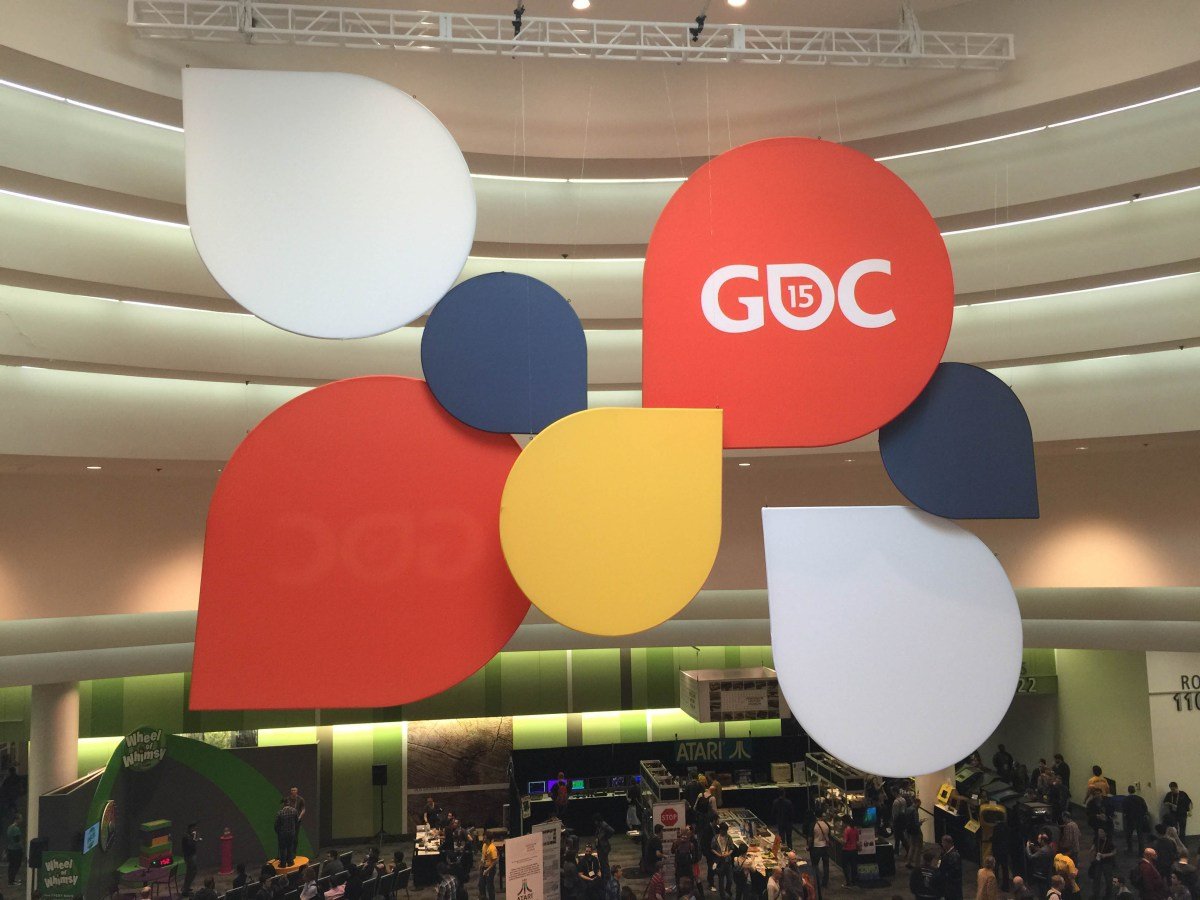





Published: Mar 11, 2015 06:30 pm